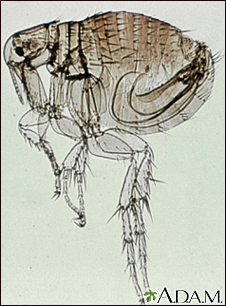Typhus
Definition
Typhus is a bacterial disease spread by lice or fleas.
Alternative Names
Murine typhus; Epidemic typhus; Endemic typhus; Brill-Zinsser disease; Jail fever
Causes
Typhus is caused by two types of bacteria: Rickettsia typhi or Rickettsia prowazekii.
Rickettsia typhi causes endemic or murine typhus.
- Endemic typhus is uncommon in the United States. It is usually seen in areas where hygiene is poor, and the temperature is cold. Endemic typhus is sometimes called "jail fever." The bacteria that cause this type of typhus is usually spread from rats to fleas to humans.
- Murine typhus occurs in the southern United States, particularly California and Texas. It is often seen during the summer and fall. It is rarely deadly. You are more likely to get this type of typhus if you are around rat feces or fleas, and other animals such as cats, possums, raccoons, and skunks.
Rickettsia prowazekii causes epidemic typhus. It is spread by lice.
Brill-Zinsser disease is a mild form of epidemic typhus. It occurs when the bacteria become active again in a person who was previously infected. It is more common in older adults.
Symptoms
Symptoms of murine or endemic typhus may include:
- Abdominal pain
- Backache
- Dull red rash that begins on the middle of the body and spreads
- Fever, can be extremely high, 105°F to 106°F (40.6°C to 41.1°C) and can last up to 2 weeks
- Hacking, dry cough
- Headache
- Joint and muscle pain
- Nausea and vomiting
Symptoms of epidemic typhus may include:
- High fever, chills
- Confusion, decreased alertness, delirium
- Cough
- Severe muscle and joint pain
- Lights that appear very bright; light may hurt the eyes
- Low blood pressure
- Rash that begins on the chest and spreads to the rest of the body (except the palms of the hands and soles of the feet)
- Severe headache
The early rash is a light rose color and fades when you press on it. Later, the rash becomes dull and red and does not fade. People with severe typhus may also develop small areas of bleeding into the skin.
Exams and Tests
Diagnosis is often based on a physical examination and detailed information about the symptoms. You may be asked if you recall being bit by fleas. If the health care provider suspects typhus, you will be started on medicines right away. Blood tests will be ordered to confirm the diagnosis.
Treatment
Treatment includes the following antibiotics:
- Doxycycline
- Tetracycline
- Chloramphenicol (less common)
Tetracycline taken by mouth can permanently stain teeth that are still forming. It is usually not prescribed for children until after all of their permanent teeth have grown.
People with epidemic typhus may need oxygen and intravenous (IV) fluids.
Outlook (Prognosis)
People with epidemic typhus who receive treatment quickly should completely recover. Without treatment, death can occur, with those over age 60 having the highest risk of death.
Only a small number of untreated people with murine typhus may die. Prompt antibiotic treatment will cure nearly all people with murine typhus.
Possible Complications
Typhus may cause these complications:
- Renal insufficiency (kidneys cannot function normally)
- Pneumonia
- Central nervous system damage
When to Contact a Medical Professional
Call your provider if you develop symptoms of typhus. This serious disorder can require emergency care.
Prevention
Avoid being in areas where you might encounter rat fleas or lice. Good sanitation and public health measures reduce the rat population.
Measures to get rid of lice when an infection has been found include:
- Bathing
- Boiling clothes or avoiding infested clothing for at least 5 days (lice will die without feeding on blood)
- Using insecticides (10% DDT, 1% malathion, or 1% permethrin)
Gallery


References
Blanton LS, Dumler JS, Walker DH. Rickettsia typhi (murine typhus). In: Bennett JE, Dolin R, Blaser MJ, eds. Mandell, Douglas, and Bennett's Principles and Practice of Infectious Diseases. 9th ed. Philadelphia, PA: Elsevier; 2020:chap 190.
Blanton LS, Walker DH. Rickettsia prowazekii (epidemic or louse-borne typhus). In: Bennett JE, Dolin R, Blaser MJ, eds. Mandell, Douglas, and Bennett's Principles and Practice of Infectious Diseases. 9th ed. Philadelphia, PA: Elsevier; 2020:chap 189.
Fournier PE, Raoult D. Rickettsial infections. In: Goldman L, Schafer AI, eds. Goldman-Cecil Medicine. 26th ed. Philadelphia, PA: Elsevier; 2020:chap 311.